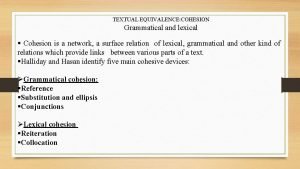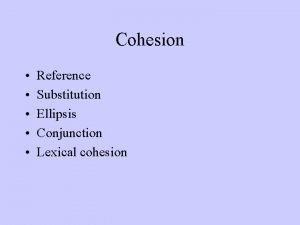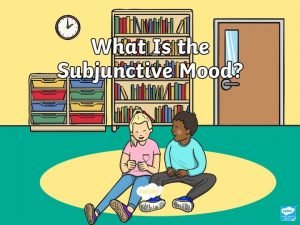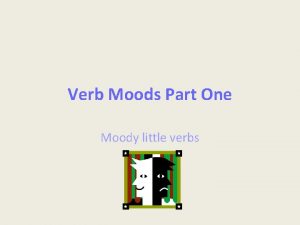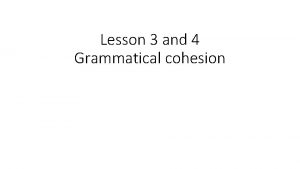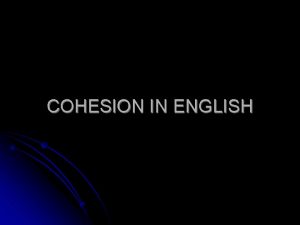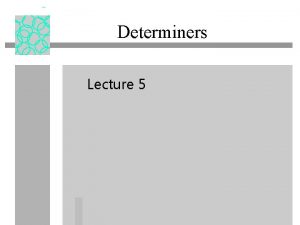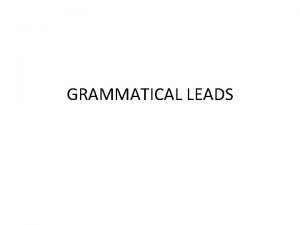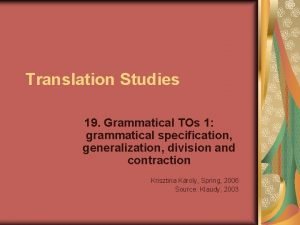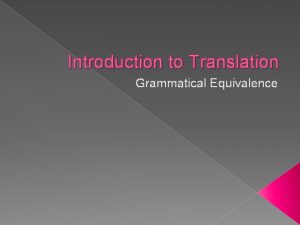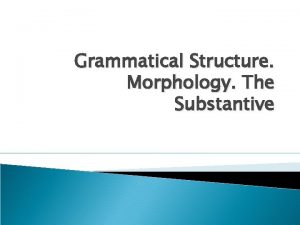Lesson 3 and 4 Grammatical cohesion Grammatical Cohesion








![Pronoun omission The woman who lives next door is a doctor The woman [who] Pronoun omission The woman who lives next door is a doctor The woman [who]](https://slidetodoc.com/presentation_image_h2/0a0d4372ab7552d1f7fde511ddfcf675/image-9.jpg)

![Det head Post-modification: relative clause The woman [who] I saw (I saw a woman) Det head Post-modification: relative clause The woman [who] I saw (I saw a woman)](https://slidetodoc.com/presentation_image_h2/0a0d4372ab7552d1f7fde511ddfcf675/image-11.jpg)

- Slides: 12

Lesson 3 and 4 Grammatical cohesion

Grammatical Cohesion These are the grammatical words (function) words that are used to link sentences across an entire text. The basic kinds are: Reference - this tells the reader that they can only make complete sense of the word or structure they are looking at if they look somewhere else in the text to complete the information. Words can reference forward (cataphoric) or backward (anaphoric) in a text. Another form of reference is exophoric (this refers to something outside the text, often this is readers themselves – as in the case of 'you' or in the case of the imperative). The opposite of this feature is known as endophoric when all reference is to items or referents strictly within the text.

Grammatical Cohesion: Connectives (conjunctions) – as their very name suggests overtly link sentences or clauses together by putting them in a spatial, temporal, logical or causal, relation. They are sometimes also referred to as linking words. While grammatical reference provides cohesion in all texts, various kinds of connectives tend to be dominant in certain kinds of genres: narratives, argumentation, etc.

Main grammatical reference words Pronouns: (including ‘there’) Deictics: (e. g. demonstrative pronouns) words that indicate or point out something present in the context. comparative reference (comparison, comparatives, superlatives) substitution this where the writer substitutes one item for another (e. g. one in the case of nouns; e. g. so (or an auxiliary or a modal) in the case of verbs. Ellipsis, in other words missing something out. Surprisingly this can actually help texts cohere because readers themselves fill in the gaps. conjunctions. As their name suggests, these are in a way the most explicit joining devices of a text. The two basic types are coordinating conjunctions, which join clauses of equal rank (and, so, but) and subordinating conjunctions, which join clauses of unequal rank (although, until, when, whether, etc) as.

Reference: pronouns • Activities Carter et al. WWT • Please note that page and activity numbers change in different editions. Here reference is made to the third edition, 2008) • Text 5: 7 (Whenever hour you woke there was a door shutting…), p. 152 • Text 5: 8 (Not waving but drowning), p. 153

Relative pronouns Which pronoun(s) can you use in each gap? That / which / who • China and Europe have agreed to set up a ‘mechanism’ ______ allows top officials to discuss economics and trade issues. • European portrayed the mechanism, ____ will hold its first meeting in March, as a direct response to trade imbalances. • “This is a cross sectoral mechanism” said Mr Wen, ____ said the forum was created at his suggestion. • Jean Claude Junker, the official ____heads the Eurogroup of finance ministers, warned of possible consequences.

• China and Europe have agreed to set up a ‘mechanism’ that/which allows top officials to discuss economics and trade issues. • European portrayed the mechanism, which will hold its first meeting in March, as a direct response to trade imbalances. • “This is a cross sectoral mechanism” said Mr Wen, who said the forum was created at his suggestion. • Jean Claude Junker, the official that/who heads the Eurogroup of finance ministers, warned of possible consequences.

Defining vs non-defining relative clauses Defining The woman who/that lives next door is a doctor Where is the cheese which/that was in the fridge? (that is more usual) NO COMMAS Non-defining My brother Jim, who (not that) lives in London, is a doctor Colin told me about his job, which (not that) he’s enjoying very much.
![Pronoun omission The woman who lives next door is a doctor The woman who Pronoun omission The woman who lives next door is a doctor The woman [who]](https://slidetodoc.com/presentation_image_h2/0a0d4372ab7552d1f7fde511ddfcf675/image-9.jpg)
Pronoun omission The woman who lives next door is a doctor The woman [who] I saw was tall What’s the rule?

Det head Post-modification: relative clause The woman who lives next door S V Adv You can’t say: The woman lives next door is a doctor Rule: you can’t leave the pronoun out when it performs the function of the subject
![Det head Postmodification relative clause The woman who I saw I saw a woman Det head Post-modification: relative clause The woman [who] I saw (I saw a woman)](https://slidetodoc.com/presentation_image_h2/0a0d4372ab7552d1f7fde511ddfcf675/image-11.jpg)
Det head Post-modification: relative clause The woman [who] I saw (I saw a woman) O S V The books [that/which] you have been looking for The girl whose car I borrowed The day [that] we first met The reason [that/why] I’m phoning you Rule: you can leave the pronoun out when it is not the subject of the (defining) relative clauses.

Other reference devices • Ellipsis, subsitution, • comparatives, • demonstrative pronouns and definite article • Cf. handout 3
 Textual equivalence
Textual equivalence Substitution reference
Substitution reference Grammatical meaning and lexical meaning
Grammatical meaning and lexical meaning What is syllabus
What is syllabus Scientific text in english
Scientific text in english Micro lesson plan example
Micro lesson plan example Sat vocabulary lesson 4
Sat vocabulary lesson 4 The science duo physical and chemical changes
The science duo physical and chemical changes Lesson 4 gravity and motion lesson review
Lesson 4 gravity and motion lesson review Lesson outline magnets and magnetic fields answer key
Lesson outline magnets and magnetic fields answer key The sun-earth-moon system worksheet answers lesson 1
The sun-earth-moon system worksheet answers lesson 1 What is subjunctive mood
What is subjunctive mood Verb moods
Verb moods
